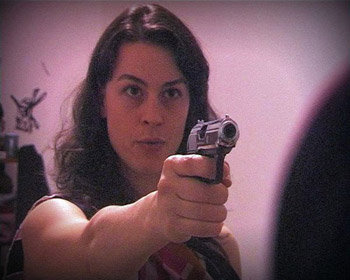Inszenierung / Mise en scene
dal 17/10/2008 al 29/11/2008
Segnalato da
Museum im Kulturspeicher Wurzburg
17/10/2008
Inszenierung / Mise en scene
Museum im Kulturspeicher Wurzburg, Wurzburg
An exhibition of the art award winners of the Kulturkreis der deutschen Wirtschaft im BDI e.V. The four prize winners are Israeli artist Keren Cytter, German artist Manuel Graf, Danish artist Simon Dybbroe Moller, and British artist Tris Vonna-Michell. A common denominator among all four positions is that their respective staging includes all scenic means available. But their special achievement consists in creating an overall effect that no longer can be traced back to the sum of the individual elements.

An exhibition of the art award winners of the Kulturkreis der deutschen Wirtschaft
im BDI e.V., Berlin in cooperation with Museum im Kulturspeicher Würzburg; Museum
Abteiberg, Mönchengladbach and Augarten Contemporary, Vienna
The Kulturkreis der deutschen Wirtschaft, Berlin is awarding this year's "ars
viva"-prize for work on the theme "Inszenierung / Mise en scène." The four prize
winners are Israeli artist Keren Cytter, German artist Manuel Graf, Danish artist
Simon Dybbroe Møller, and British artist Tris Vonna-Michell. In conjunction with the
award the exhibition series "ars viva" presents a selection of works by the
award-winners at three venues for contemporary art. The Kulturkreis publishes a
bilingual (English/German) exhibition catalogue presenting the work of the
award-winners, as well as a small number of artists' editions.
The variety of the various works and approaches of Keren Cytter, Manuel Graf, Simon
Dybbroe Møller, and Tris Vonna-Michell makes clear how much the issue of mise en
scène and questions of staging have self-evidently penetrated the art of recent
years and intensely shaped it. A common denominator among all four positions is that
their respective staging includes all scenic means available. But their special
achievement consists in creating an overall effect that no longer can be traced back
to the sum of the individual elements. Only in the application of this principle,
which surpass a direct link to the material, can the staging be attributed a style
of its own, for which a plan-ning authority is responsible (which itself is or is
not a recognizable part of the staging). The jury was in particular convinced that
the scenarios presented by Simon Dybbroe Møller and the installations and
performances by Tris Vonna-Michell were of conceptual significance to the actions
and ex
pe-riences of visitors to the exhibition. In Keren Cytter's short films and Manuel
Graf's installations, the experimental processes employed to make strategies of
staging visible played an important role.
Keren Cytter, born in 1977, uses both docu¬mentary and fictional elements in her
brief films. At the same time, they are commentaries on the medium of film and its
narrative conventions. They combine the struc¬ture of classical drama in theater
with the melodramatic and the grotesque, with quotations from popular and low
culture. Multilayered narrative layers are superimposed upon the interpersonal
relationships depicted, the actors play out their roles and comment at the same time
on the work on the film.
Manuel Graf, born in 1978, surrounds his videos and 3D animations with self-built
models and light installations, that combine high tech with do-it-yourself
aesthetic. Toys, sets, stage models, peepholes, and spotlights serve as tools in his
designed miniature worlds, which possess a nostalgic aura all their own, to pursue
fundamental questions about the origin and truth of our (cultural) history. Manuel
Graf discovers the use of models as a modification of static, canonized knowledge
production to dehierarchized processual re-translations, not by explaining, but by
comparing.
Simon Dybbroe Møller, born in 1976, composes spatial scenarios with found or
existing objects that the spectator passes through as apparently coincidentally
emerged situations. Often embedded in the context of modern life, the objects thus
reveal connections and little stories whose immanent logic convinces the beholder of
the existence of these staged, everyday occurrences. He problematizes the
relationship between presence and representation, singularity and repletion,
immediacy and reproduction, and how he short circuits the moment of the staged event
with processes of mediation.
Tris Vonna-Michell, born in 1982, has been developing various historical strains
that oscillate between fact and fiction and can be staged as performances and
scenery-like installations. In so doing, he links the tradition of "oral history"
with objects, slide projections, texts, and personal memorabilia that serve as props
for his breathtakingly rapid performative monologues. It is precisely the ephemeral
quality of his works as well as the use of texts, of real and fictive narrative
fragments in his installations, which achieve the overall impression of an
inexorable oscillation between present and past, absence and presence, consciousness
and memory, taking us to the core of an idea of the perfor¬mative.
This year's jury headed by Arend Oetker, chairman of the fine arts board of the
Kulturkreis der deutschen Wirtschaft, Berlin is comprised of the curators Beate
Reese (Museum im Kulturspeicher Würzburg); Susanne Titz (Museum Abteiberg,
Mönchengladbach); Eva Maria Stadler (Augarten Contemporary, Vienna); Doris Krystof
(K21 Kunstsammlung Nordrhein-Westfalen, Düsseldorf) and six members of the fine arts
board of the Kulturkreis der deutschen Wirtschaft.
The prize is awarded October 18, 2008 in conjunction with the opening of the
exhibtion at Museum im Kulturspreicher Würzburg. „ars viva 08/09 – Inszenierung /
Mise en scène will subsequently be shown at Museum Abteiberg, Mönchengladbach (March
1 – May 24, 2009) and Augarten Contemporary, Vienna (June 6 – September 27, 2009).
The exhibition is accompanied by a catalogue (English / German) with essays by
Doris Krystof, Catrin Lorch, Susanne Pfeffer, Mirjam Schaub, Oliver Tepel, 176
pages, 79 illustrations, 63 in color, Hatje Cantz Verlag.
Opening and award ceremony: October 18, 2008, 8 p.m.
Museum im Kulturspeicher Wurzburg
Veitshochheimer Str. 5 - Wurzburg



